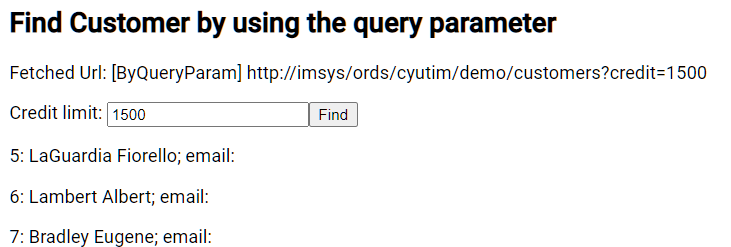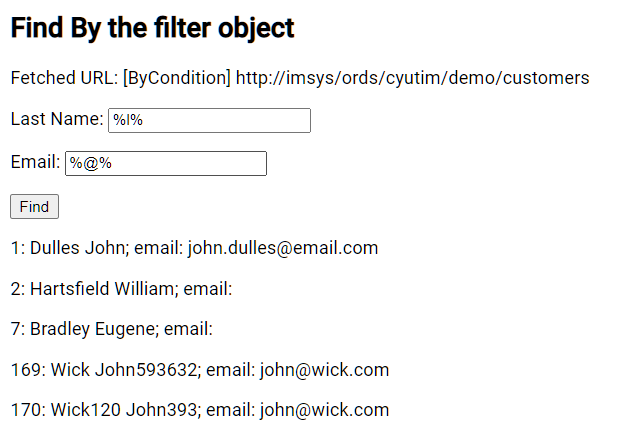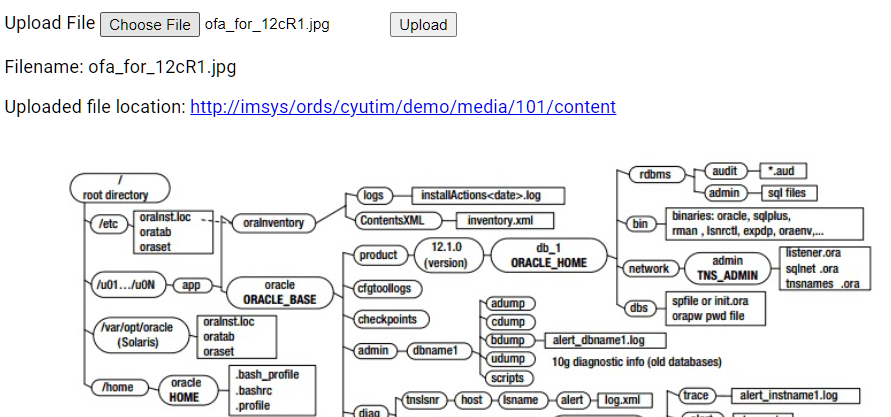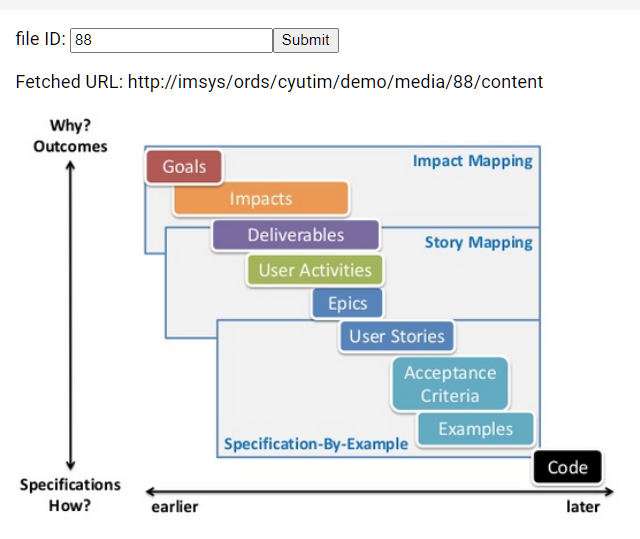Unit 22 使用 HttpClient 取得及上傳文字及圖片
簡介
介紹使用 Angular HttpClient 取得及上傳文字及圖片。
首先介紹取得文件料, 介紹的取得方式包括: URL Parameter, Query Parameter, 及 Filter Object。接著介紹上傳文件資料、上傳圖片、及取用圖片時使用的前、後端的程式碼。
其中 Filter Object 為 Oracle ORDS 提供的功能, 利用 Filter Object 指定複雜的過濾條件即可進行資料的過濾, 後端並不需要特別撰寫過濾的程式。對程式開發, 此功能提供很高的彈性。
取得文字資料
回傳資料格式定義
ORDS 回傳資料的介面定義:
1
2
3
4
5
6
7
8
export interface ORDSResponse<T> {
items: T [];
hasMore: boolean;
limit: number;
offset: number;
count: number;
links: object [];
}
取得特定編號的顧客
Resource URL: http://imsys/ords/cyutim/demo/customer/{id}
回覆資料: ORDSResponse<T>
客戶端程式
1
2
3
4
5
6
7
8
9
10
public getCustomerById(resourceUri: string, id: number):
Observable<Customer> {
// #1 建立 resource 的 URL
const fullResourceUrl = this.getModuleUri() + resourceUri + '/' + id;
return this.httpClient.get(fullResourceUrl).pipe(
//#2
map((body: ORDSResponse<Customer>) => body.items[0]),
tap(console.log)
);
說明:
- 查詢的參數放在 url 中. 此類型參數稱為 URL parameter
- 查詢的結果存放在
ORDSResponse<T>.items中, 利用map()operator 取出並回傳。

使用 Query parameters 查詢
Resource URL: http://imsys/ords/cyutim/demo/customer?credit=xxx
請求:
- Query Parameter:
?credit=xxx
回覆資料: ORDSResponse<T>
Server 端程式
ORDS 中的 get handler 將 credit query parameter 對應成 binding variable.
1
2
3
4
5
6
SELECT * from
(select c.* ,
ROW_NUMBER() OVER (ORDER BY customer_id asc)
from demo_customers c
where c.credit_limit = nvl(:credit, c.credit_limit)
)
客戶端程式
1
2
3
4
5
6
7
8
9
10
11
12
13
14
15
16
17
18
19
20
21
/**
* 使用 Query Parameter 進行查詢. Query Parameter 必須在 SQL 程式中有對應的 bind variable.
* @param resourceUri
* @param paramName Query Parameter 名稱, 如 credit
* @param paramValue Value of the query parameter., 如 credit=1500
*/
public findCustomerByQueryParameters(
resourceUri: string,
paramName: string,
paramValue: string): Observable<Customer[]> {
const fullResourceURL = this.getModuleUri() + resourceUri;
// #1
const queryParams: HttpParams = new HttpParams()
.set(paramName, paramValue);
// #2
return this.httpClient.get(fullResourceURL, {params: queryParams})
.pipe(map( (response: ORDSResponse<Customer>) => response.items));
}
說明:
- 建立查詢參數
queryParam - 將查詢參數當成
option傳入httpClient.get()中。

使用 FilterObject 進行查詢
Resource URL: http://imsys/ords/cyutim/demo/customers
請求:
- query parameter:
?q=filterObject
回覆資料: ORDSResponse<T>
Server 端程式
ORDS 的 GET handle 不需要有任的 bind variables.
ORDS 會處理 Filter Object, 將之轉換成 where 條件。
客戶端程式
1
2
3
4
5
6
7
8
9
10
11
12
13
14
15
16
17
18
19
20
21
22
23
24
25
26
27
/**
* 使用 cust_last_name 及 cust_email 兩個欄位過濾查詢結果.
* 兩個條件 OR.
*
* @param resourceUri Resource URI
* @param lastnameQueryValue 部份的 last name 字串, 使用 like op 查詢
* @param emailQueryValue 部份的 email 字串, 使用 like op 查詢
*/
public findCustomersByLastnameEmail(
resourceUri: string,
lastnameQueryValue: string,
emailQueryValue: string): Observable<Customer[]> {
// #1
const filterObject = `{"CUST_LAST_NAME": {"$or": [
{"$like": "${lastnameQueryValue}"},
{"CUST_EMAIL": {"$like": "${emailQueryValue}"}}]}
}`;
// #2
const queryParam: HttpParams = new HttpParams().set('q', filterObject);
// #3
const fullResourceURL = `${this.getModuleUri()}${resourceUri}`;
// #4
return this.httpClient.get(fullResourceURL, {params: queryParam})
.pipe(map( (response: ORDSResponse<Customer>) => response.items ));
}
說明:
- 建立 Filter Object. 產生的過濾條件:
1
CUST_LAST_NAME LIKE '[lastnameQuery]' AND CUST_EMAIL LIKE '[emailQueryValue]'
- 建立 Query Parameter
q - 產生 Resource URL
- 執行查詢並回傳
Observable<Customer[]>

上傳文字資料
上傳 Customer 物件到資料庫。
資料格式
Customer 物件的定義:
1
2
3
4
5
6
7
8
9
10
11
12
13
14
15
16
17
18
19
20
21
22
/**
* Map to the demo_customers table in the cyutim schema in the imsys database.
*/
export class Customer {
// tslint:disable-next-line:variable-name
constructor(public customer_id?: number,
// tslint:disable:variable-name
public cust_first_name ?: string,
public cust_last_name ?: string,
public cust_street_address1 ?: string,
public cust_street_address2 ?: string,
public cust_city ?: string,
public cust_state ?: string,
public cust_postal_code ?: string,
public cust_email ?: string,
public phone_number1 ?: string,
public phone_number2 ?: string,
public url ?: string,
public credit_limit ?: number,
public tags ?: string
) {
}
注意, 欄位名稱和資料庫的欄位名稱一致, 方便對映處理。
資源 URL及請求與回覆間的協定
Resource URL: Resource URL: http://imsys/ords/cyutim/demo/customer
請求的 header body 放置要新增的 JSON 格式的 Customer Object。
回應的 header 中有 location 參數, 提供新增的 Customer 的 URL, 供後續存取。
Server 端程式
ORDS 的 Handler 的程式:
1
2
3
4
5
6
7
8
9
10
11
12
13
14
15
16
17
18
19
20
21
22
23
24
25
26
27
28
29
30
31
32
33
34
35
36
37
38
39
40
41
42
43
44
45
46
47
48
49
50
51
52
-- PL/SQL Handler Code Used for a POST Request
-- hychen39@gmail.com
-- 2021/05/29
declare
l_body_blob blob;
l_body_clob clob;
l_content_type varchar2(200);
l_id number;
l_name varchar2(50);
l_err_msg VARCHAR2(300);
begin
-- Get the request body from the implicit binding variable :body
l_body_blob := :body;
-- Get the content type
l_content_type := :content_type;
-- Convert the body's data type from blob to clob
l_body_clob := UTL_RAW.cast_to_varchar2(l_body_blob);
if l_body_clob is null then
-- 回覆給 Client 的訊息
htp.print('l_body_clob is EMPTY');
return;
end if;
-- Call the handler in the package
-- 建立 Customer 的 package procedure.
demo_customers_rest.customer_post_handler(
p_body=>l_body_clob /*clob*/,p_customer_id=> l_id /*varchar2*/
);
commit;
-- 回覆狀態碼.
:status_code := 201;
-- 放在在 Response Header 的參數
--- './' means the current module url.
:location := './' || '/customer/' || l_id;
-- htp.prn('{"id": ' || l_id || '}');
-- Exception handling
EXCEPTION
when others then
l_err_msg := sqlerrm;
-- 回覆 client 有關 Server 端的錯誤訊息.
htp.prn(l_err_msg);
end;
客戶端程式
Service Method
1
2
3
4
5
6
7
8
9
10
11
12
13
14
15
16
17
18
19
20
21
22
23
24
25
26
/**
* Post a new customer to database.
* @param resourceUri
* @param newCust
*/
public createCustomer(resourceUri: string, newCust: Customer): Observable<string> {
// #1 Assemble the full url for the resource template
const fullUrl = this.getModuleUri() + resourceUri;
// #2 convert object to json text
const customerJson = JSON.stringify(newCust);
// #3 post to server and return the location in the response
return this.httpClient.post(fullUrl, customerJson,
{ //#4
observe: 'response' as const,
responseType: 'json' as const
}).pipe(
// #5
map((response, index) => response.headers.get('location')),
// #6
catchError((err: HttpErrorResponse) => {
// #7 回覆 error 表示串流錯誤, 讓 Observer 能夠呼叫其 error function 處理例外.
return throwError(err.error.text as string);
}));
}
說明:
- 組合成完整的 URL。
- 轉換 Customer 物件成為 JSON 格式字串。
- 呼叫
httpClient.post()。 - 呼叫選項指定取得 http response (包含 header 及 body); 內容格式為 JSON 格式。
- 取得位於 response header 內的 location 參數的值, 回傳
Observable<string>。 - 處理 Http response 錯誤, 取得 Server 端回傳的錯誤訊息, 回傳
Observable<string>。

上傳圖片
資源 URL及請求與回覆間的協定
Resource URL: http://imsys/ords/cyutim/demo/media
請求 Header 參數
- file_name: string, 檔案名稱
- file_type: string, 檔案的型態, 例如: image/png
請求 Body
- 上傳的檔案或圖片
回覆 Header 參數
- location: string, 上傳的檔案或圖片的 URL
Server 端程式
1
2
3
4
5
6
7
8
9
10
11
12
13
14
15
16
17
18
19
20
21
22
23
24
25
26
27
28
29
30
31
32
declare
l_image_id number :=0;
l_url varchar2(300);
l_body blob;
l_err_msg VARCHAR2(300);
begin
-- uploaded file is placed in the body.
-- Restful service does not support the multipart/form-data protocol
l_body := :body;
-- :file_name, :file_type are defined in the parameter panel.
insert into demo_media
values ( DEMO_MEDIA_SEQ.nextval , :file_name, :file_type, l_body)
RETURN id into l_image_id;
commit;
-- 回覆客戶端狀態碼
-- http status code that is defined in the parameter panel.
:status := 201;
-- 回覆客戶端狀 location 參數
-- Set the Location parameter in the http request
-- './' represents the module uri
-- The URL for the resource URL template media/:id/content
:location := './media/' || l_image_id || '/content';
exception
WHEN OTHERS then
l_err_msg := sqlerrm;
-- 回覆客戶端例外訊息
htp.print(l_err_msg);
end;
客戶端程式
1
2
3
4
5
6
7
8
9
10
11
12
13
14
15
16
17
18
19
20
21
22
23
24
25
26
27
/**
* Upload the file and return the URL location in the response header.
* @param resourceUri
* @param fileToUpload
*/
public uploadFile(resourceUri: string, fileToUpload: File): Observable<string> {
// #1
const fullResourceURL = this.getModuleUri() + resourceUri;
// #2
// prepare the request header
// 注意: set() 是 immutable function, 回傳 A clone of the HTTP headers
const httpHeaders = new HttpHeaders()
.set('file_name', fileToUpload.name)
.set('file_type', fileToUpload.type);
// #3
return this.httpClient.post(
fullResourceURL,
// #4
fileToUpload,
// #5
{headers: httpHeaders, observe: 'response' as const})
// #6
.pipe(map((response, index) => response.headers.get('location'))
);
}
說明:
- 組合成 full url
- 建立 request header, 放入 file_name 及 file_type
- 呼叫
httpClient.post() - 要上傳的檔案, 型態為 Web API 中的 File 介面型態
- 呼叫 post() 傳入的選項
- 取得 Response Header 中的
location參數

取得圖片
資源 URL及請求與回覆間的協定
Resource URL: http://imsys/ords/cyutim/demo/media/:id/content
請求:
- 圖片 id 放在 URL parameter
回覆
- 檔案或圖片放在 http body
Server 端程式
1
2
3
4
5
-- SQL 的 column 第一個為 http header 中的 content-type,
-- 第 2 個 column 為放在 response body 中回傳的檔案或圖片.
select content_type, content
from demo_MEDIA
where ID = :id
客戶端程式
1
2
3
4
5
6
7
8
9
/** Fetch file or image from Server.
* Ref: https://stackoverflow.com/a/45630579/7820390
* @param resourceUri
*/
public fetchFile(resourceUri: string){
const fullURL = this.getModuleUri() + resourceUri;
//#1
return this.httpClient.get(fullURL, {responseType: 'blob' as const});
}
說明:
- 呼叫
httpClient.get(). 在呼叫選項中, 指定回傳的資料型態為 BLOB, HttpClient 會自動的取出 Http Response Body 中的內容。
